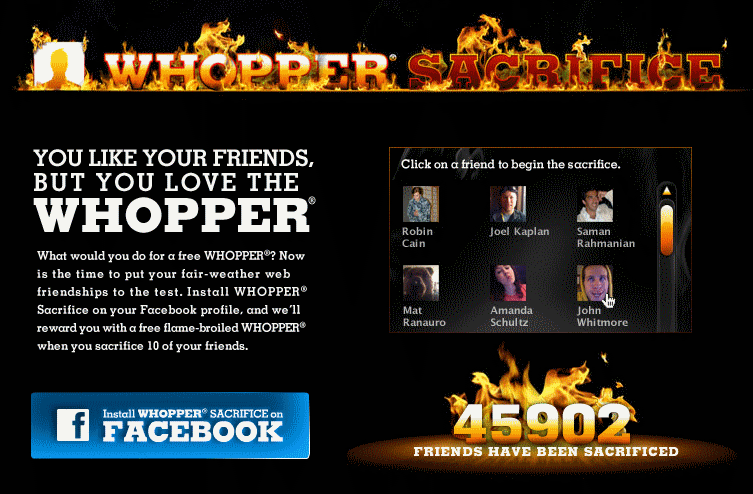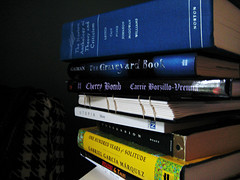When Being Difficult Has Its Benefits
In a recent Boston Globe article Easy=True, Drake Bennett examines the psychological effects of cognitive fluency and disfluency -- how people react to things based on how easy or difficult they are to process. Bennett concludes that humans "are suspicious of difficulty, but perhaps we can learn to use that."
Marketers have much to learn from the findings that Bennet explores. While usability experts have long practiced the art of making things easy, there's also much to learn from making things difficult or less familiar (familiarity plays a vital role in the ease of processing).
When answering questions posed in less legible font, people answer more honestly. When products are less familiar, they are perceived as more innovative. Crisp, light writing may be easier to read, but the content of dense writing appears more complex, even if it isn't -- a clear benefit for anyone trying to leverage a position of thought leadership.
"Fluent things are familiar, but also boring and comfortable" says Piotr Winkielman. "Disfluency is intriguing and novel. Sometimes you like comfort food, like when you’re sick. And usually you want to try something new when you’re more comfortable."
These findings reveal to marketers the importance of the customer's psychological state. Will the product be ignored if it's too unique, or will it be the recipient of adoration for breaking outside the box? Will users enjoy this cunning feature on the website, or will they reject it as unfamiliar?
The answers to these questions largely depend on how bored and comfortable people are with their current options. In a boring and comfortable space, a bit of disfluency can go a long ways towards appearing as a fresh alternative. On the other hand, in rapidly changing spaces, people are less receptive to radical design approaches.
Rather than focusing solely on making things easy to use, marketers and designers need to be collaborating to gauge the market. Are they ready for innovation or are they hungry for consistency? How much of the unfamiliar and difficult will they embrace, and when is too easy too boring?
How Three Brands Took Stale Ideas and Created Something Awesome
No brand is completely unique when you abstract their message or offer; it's sexy, efficient, cost-saving, fun, reliable...and the list goes on, but we've seen them all before. It's not surprising then that most people are bored by advertising: it's all unoriginal. So, how do you stand out?
Below are just three of our favorite recreations of otherwise boring, unoriginal ideas. They each take something that at first appears completely uninteresting (a story about brand history, a coupon, and a pitch on product quality) and make it unforgettable through the power of creativity.
It's Not What You Say, But How You Say It
When it comes to brand messaging, heritage and history are old-time favorites; at one point or another any brand that's been around long enough to have a history will try to take advantage of it. The downside is it's been done before, and if you go down that road, you'll be admitting that you don't have anything unique to say.
Or do you?
This short film for Johnnie Walker whiskey is an excellent example of a unique, well-executed piece of creative that's based on the same old story of brand history.
Many brands try to be too many things, often leaving brand history as a sidenote tacked on at the end -- founded in 1869. Ten strong messages might be better than one, but most of the time the strength of ideas the brand can build around are diluted in strength as they increase in number. Johnnie Walker picked one message, allowing them to focus everything -- setting, script, casting, and camera style -- towards that message. The result was a home run.
The lesson? It doesn't matter if the best message for your brand starts out sounding like someone else, as long as you say it in your own way.
How To Make A Coupon That Isn't Boring
About a year ago, Crispin Porter and Bogusky launched the most remarkable social media campaign to date. With the campaign's goal in mind -- driving whopper sales -- a coupon made sense, but Whopper Sacrifice was more than a coupon, it was an experience.
In reward for the small task of removing 10 Facebook friends using the Whopper Sacrifice Facebook application, users were able to appease the whopper god enough to earn a free burger.
In the end, Facebook banned the application, but not before 234,000 friends were sacrificed for the sake of a free whopper. While Whopper Sacrifice is an important campaign to remember for several reasons (it exhibits a keen understanding of the customer, a more advanced use of social media, and a great sense of humor,) for this discussion it's enough to point out that at it's core Whopper Sacrifice was a simple coupon -- a short activity in exchange for a free burger. It's refreshing to think that next time you want to drive sales you can still rely on the good old coupon strategy and not come off as boring or stale.
A Slogan Worthy Of The Brand
Like building a brand message based on rich history, trying to sell a product on it's quality isn't exactly a fresh idea. Enduring, long-lasting, and reliable all go in one ear and out the other. People here these words as advertiser speak that translates into "just like everyone else".
A great example of both a rich brand history and a creative approach to delivering a unique selling proposition, Saddleback Leather Company doesn't just sell long-lasting bags; they sell bags that "they'll fight over when you're dead" according to their slogan.
It's a unique message for a fittingly unique selling proposition. Lots of people might make quality bags, but only Saddleback makes bags with a 100 year guarantee. In order to successfully portray their competitive advantage they need to be creative in their delivery. A slogan like "reliable leather products since 1999" would be the kiss of death to a brand like this. "They'll fight over it when you're dead" is the breath of life.
The power of creativity to take something old and unoriginal and make it fresh and fascinating is the driving force behind successful campaigns like these, but these examples are just the tip of the iceberg. If you know any ads or brands that have done something similar, feel free to share them in the comments or send us a tweet.
Customer Experience, The Ultimate Acquisition Model
In light of the advancing trend towards products as communication channels (see: Nike+, Helge Tenno, and Russell Davies), it's apparent that the worlds of product design and marketing are creeping steadily towards each other. But what's driving this movement is more than just technology, it's the simple realization that the ultimate acquisition model is a superb customer experience.
While there's certainly a place for efficient direct sales campaigns, marketers are now, more than anything, care takers of the brand. This is the reason Starbucks cares about the atmosphere they create, why companies invest in great websites, why the social media bandwagon is so large, and why all of the branding fluff continues to draw discussion -- because beneath the fluff there is substance.
Over the years, advertising has grown more targeted and consumers have become more accessible. Simultaneously, and not coincidentally, consumers have grown weary of advertising. For most people, the contradictions between advertisements and their real life experiences with brands are too big too ignore.
But the problem isn't just the advertisements themselves -- granted, the click the monkey ads don't help the situation -- the problem is that as advertising increases, so does brand scrutiny. The more often consumers are bombarded with ads, the more opportunities they have to notice inconsistencies between the brand's message and their personal experiences.
So, where does that leave us? It leaves us with many brands who are in desperate need of a clean slate. More and more companies are starting to realize that their biggest weakness is their product. As the CEO at Dominoes puts it, "The weakness in our value chain with the customer was really in our core product."
What's the takeaway?
For brands and agencies alike, the time ahead requires more collaboration and more interdisciplinary skills than before. Brands that want to be effective need marketers that understand the importance of customer experience (and how to shape it), and agencies that want to stay relevant need a team that can advise brands from the ground up, getting involved in products from the beginning with insights that move beyond messaging and into product experiences.
Four Reasons Why People Turn to Fiction (Marketers Pay Attention)
For many of us, reading a work of good fiction is more than just a way to pass the time. It's a window into other people and places, an emotional catharsis, and a framework upon which to build our understanding of the world around us. In this post, Rob Parnell of Easy Way to Write explains fiction for those who don't understand its value. Fiction, like film, is simply another medium for stories, he says. People enjoy stories for four reasons:
- Entertainment
- Enlightenment
- Validation
- Hope and Salvation
In the ongoing discussion around branding, brands are frequently compared to stories. Is this comparison accurate? We believe it is. A brand that entertains, enlightens, validates, or offers hope to its customers is likely to grow in the right direction. People will turn to the brand in the same way that they turn to their favorite stories.
Do marketers need to read fiction? Probably not, but they do need to be in touch with the world of stories. Having an understanding of stories -- why people enjoy them and hold on to them -- will help you understand how to create content, messaging, and engagements that are effective. If you don't feel like losing yourself in One Hundred Years of Solitude, you can still benefit from movies, plays, standup comedians, and magazine articles, which are all great places to connect with the world of stories.
Do you have a story of your own? Share it in the comments or send us a tweet.
image via http://www.flickr.com/photos/the8rgrl/2949316275/sizes/m/
The Secret to Enjoying Your Work
Boring work is bad work. It's bad for the company and for the employee. When people get bored, they dream about the grass on the other side. Their productivity decreases; they become dissatisfied with their work, and things start to spiral steadily downward. Today, people stay at jobs for less time than ever, and more of them are dissatisfied with their work than they have been since 1987. You can wager, too, that they're more bored than ever. What's the cure for this boredom?
"The cure for boredom is curiosity. There is no cure for curiosity." -Dorothy Parker
Being curious isn't just the cure for boredom, it's the antithesis of boredom. You cannot be curiously bored. But how do you stay curious? What if you're the type of person who craves change, but you've been in the same job for ten years? If you're struggling with boredom, here are five tips to keep you curiously engaged in your workplace:
- Learn how to do what a colleague does. You'll become more valuable, and you'll have something besides your normal tasks to think about.
- If you have a routine, change it. Throw a kink in the machine. Get up earlier. Take a different route to work. Go somewhere new on the weekend.
- Read blogs and books by the respected leaders in your industry. Along the way, you'll find yourself more interested in what you're doing. It's always surprising and refreshing to have your eyes opened.
- Ask your boss what you can do to improve or contribute. The chances are good you'll be assigned new tasks and forced to adapt.
- Cultivate energy. Energy helps you stay positive and plow through tedious tasks. Try eating healthier, getting some exercise, sleeping appropriate amounts, and taking breaks for fresh air and sunshine.
At NeboWeb we love what we do, largely because we try to stay curious. If you have any other tips for staying curious, drop them in the comments or send us a tweet.


